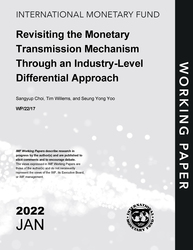
Revisiting the Monetary Transmission Mechanism Through an Industry-Level Differential Approach
Revisiting the Monetary Transmission Mechanism Through an Industry-Level Differential Approach
READ MORE...
Volume/Issue:
Volume 2022
Issue 017
Publication date: January 2022
ISBN: 9798400201028
$20.00
Add to Cart by clicking price of the language and format you'd like to purchase
Available Languages and Formats
| English |
Prices in red indicate formats that are not yet available but are forthcoming.
Topics covered in this book
This title contains information about the following subjects.
Click on a subject if you would like to see other titles with the same subjects.
Banks and Banking , Exports and Imports , Finance , Economics- Macroeconomics , Money and Monetary Policy , Economics / General , Monetary policy transmission , Industry growth , Financial frictions , Asymmetry in transmissions , balance sheet channel , channel of monetary policy , differential approach , IMF working papers , monetary policy stance , Financial statements , Central bank policy rate , Exchange rates , Monetary tightening , Export fluctuations , Global , credit channel , monetary policy shock , effects of monetary policy , x MPS , shock series , Credit , Financial sector development
Summary
We combine industry-level data on output and prices with monetary policy shock estimates for 105 countries to analyze how the effects of monetary policy vary with industry characteristics. Next to being interesting in their own right, our findings are informative on the importance of various transmission mechanisms (as they are thought to vary systematically with the included characteristics). Results suggest that monetary contractions reduce output by more in industries featuring assets that are more difficult to collateralize, consistent with the credit channel, followed by industries producing durables, as predicted by the interest rate channel. The credit channel is stronger during bad times as well as in countries with lower levels of financial development, in line with financial accelerator logic. We do not find support for the cost channel of monetary policy, nor for a channel running via exports. Our database (containing estimated monetary policy shocks for over 170 countries) may be of independent interest to researchers.
Copyright © 2010 - 2025
Powered by:
AIDC



